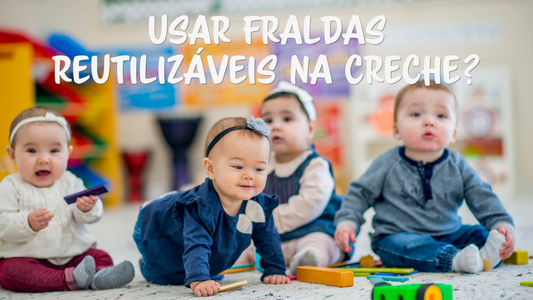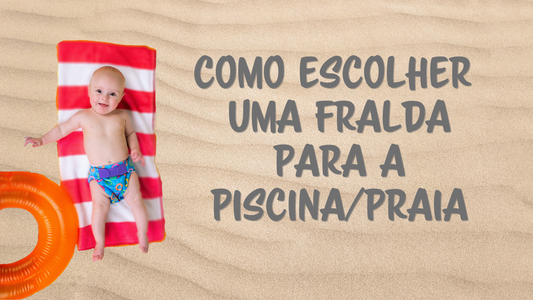How to disinfect reusable diapers?

Simplify with me the disinfection of cloth diapers?
First to first. When do you need to disinfect diapers?
You only need to disinfect your diapers for three reasons:
- Your baby has a fungus, bacteria or virus.
- Your washing routine isn't great. A bad routine for washing reusable diapers causes bad smells and waste build-up in diapers.
- In case you bought second-hand reusable nappies and you don't know how they were treated.
The disinfection of reusable cloth diapers is an aggressive process on the fibers.
Se constantly disinfecting your reusable diapers will ruin them and they won't last until potty training. Why? Because regardless of the type of disinfection you choose to do the additives are strong and end up ruining the diapers in the long run.
How to know if your baby has a fungus?
Only a doctor can confirm and in those cases you really need creams for your baby to recover. Forget about homemade mezinhas. When there is a fungus or virus, your baby's intestinal flora is unbalanced and this is what causes redness, pimples, etc.
In other words, your baby is “roasted” because there is an excess of bacteria, which happen to always live inside us. And these critters are stubborn. They like to breed in water, which is why you can never leave dirty diapers to soak, and some can withstand washing at high temperatures.
It's a vicious cycle, your baby infects the diapers and they infect your baby.
When I decided to update myself on this topic, it was because I said enough! On social networks, they are always blaming bad smells and diaper rash on the lack of hygiene in reusable diapers. are always to “order” to be washed with bleach, vinegar, essential oils, etc.
I know it's not bad. only that some of these tips ruin your diapers and others don't work.
Some advice is so ineffective that I don't understand why it reappears years after it was demystified. To use essencial oils to disinfect? Seriously? We had already ended that myth in 2013 and here it is again.
And I use essential oils for a lot of topical stuff. But, to disinfect your diapers you would need 1 liter of tea tree oil not 15 drops in the detergent drawer.
And the vinegar? Whether it's cider or wine, it helps with sores on your skin, softens your hair and cleans your washing machine if you add baking soda (in the drum! Be careful that the reaction burns). only that it won't kill the bugs that have moved into your diapers.
In these cases, you need temperature help, additives and you should talk to someone who understands.
In order to have correct and safe information for reusable diapers, I spoke with the brands. They know the best way to take care of diapers so they last a long time.
So how is it done?
How to disinfect reusable diapers?
I'm honest, in the USA there is an indication and in Europe another.
Where the marks coincide is in the wash temperatures. Washing at 60°C kills most molds including candida (one of the most common). Washing above this temperature will damage the elastic and waterproof layer of diapers as well as delicate fabrics such as bamboo.
In the USA there is an indication to use diluted bleach in washing to disinfect and in Europe the indication is to use disinfectant because bleach eliminates the guarantee of diapers.
Totsbots told me that washing their diapers above 60ºC and using bleach makes the guarantee unfeasible. their recommendation is washed at 60°C and added Dettol or Santol in the wash.
A Grovia, Thirties, Kangacare, Blueberry e Bumgenius. They explained that bleach used correctly and rarely does not spoil diapers. But constant use destroys them.
I will explain the two methods for disinfecting reusable cloth diapers. And when you need it, you can choose one of them.
Important! Before doing a disinfection, you have to wash your diapers thoroughly. If you prefer, you can do a stripping.
Disinfect reusable nappies: with disinfectant – Santol or Dettol
- Start with your clean diapers;
- He adds Dettol or Santol in the detergent drawer as indicated on the package;
- Wash your nappies in a cycle for heavily soiled clothes at 60°C;
- Do a spin or a short cold cycle, with just water, to remove any residue that may have remained from the additive in the diapers.
For sporadic use, you can add Sanytol to the washing drawer every 6-8 weeks.
Disinfect reusable diapers: with bleach
It always starts with clean diapers. If you choose to use bleach, disinfect with the window open or in an airy space. Bleach is very strong and is bad for “impulses” (as my great-grandmother used to say)
- In a large basin or bathtub, place cold water.
- For every 10 liters of water put 15ml of bleach. Dilute the bleach in water very well and wear gloves to avoid reactions on your skin.
- One by one, put on the diapers and pads. Soak for only 30 minutes;
- Remove the water and pass everything through warm water;
- Now for the washing machine. Wash your diapers on a cycle for heavily soiled clothes, with water only, to remove the bleach;
- Do a spin or a short cold cycle, with water only, to remove any residue that may have remained on the diapers.
For disinfection every 6-8 weeks recommended by Bumgenius. Follow the same steps as for disinfection with disinfectant. With these changes:
- 60ml of bleach in the detergent drawer and;
- The cycle for heavily soiled clothes with cold water.
With bleach, you need to be very careful, your baby can easily react. Always do the last spin to ensure that no residue is left.
And when is it time to get the vaccines? It is only in cases of extreme sensitivity that extreme care is needed. Avoid complicating what is simple.
If you wash your diapers at 60°C you won't have any problems. I know you'd rather play it safe and be quiet. Wash your diapers well at 60ºC and add Sanytol in the wash drawer. Simple and efficient.
The only important care to be taken is when handling the poop, wash your hands well so you don't contaminate it.
I needed to disinfect the diapers on two occasions. My son had candida twice and it was complicated. I had no idea how easily he could have resolved the situation. Now I know and that's why I want you to also know how to do it in the best way. And that way protects your baby and your diapers. If you want to receive exclusive content on how to use reusable diapers without leaks, subscribe to the newsletter.



